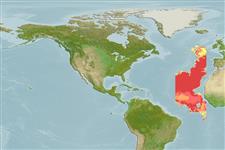Teleostei (teleosts) >
Gadiformes (Cods) >
Macrouridae (Grenadiers or rattails)
Etymology: Echinomacrurus: Greek, echinos = sea urchin, hedgehog + Greek,makros = big + Greek, oura = tail (Ref. 45335).
Environment: milieu / climate zone / depth range / distribution range
Ecology
Marine; bathypelagic; depth range 4000 - 6000 m (Ref. 557). Deep-water; 55°N - 6°S, 40°W - 15°W
North Atlantic: northeast of Mid-Atlantic Ridge, east of Great Meteor Tablemount.
Size / Weight / Age
Maturity: Lm ? range ? - ? cm
Max length : 46.5 cm TL male/unsexed; (Ref. 37108)
Short description
Identification keys | Morphology | Morphometrics
Band of small pointed teeth in both jaws. Body light brownish to olivaceus green (Ref. 37108).
Inhabits bathypelagic to benthopelagic (Ref. 37108).
Life cycle and mating behavior
Maturity | Reproduction | Spawning | Eggs | Fecundity | Larvae
Wheeler, A., 1977. Das grosse Buch der Fische. Eugen Ulmer GmbH & Co. Stuttgart. 356 p. (Ref. 557)
IUCN Red List Status (Ref. 130435: Version 2024-2)
Threat to humans
Harmless
Human uses
Fisheries: of no interest
Tools
Special reports
Download XML
Internet sources
Estimates based on models
Preferred temperature (Ref.
123201): 2.3 - 2.6, mean 2.4 °C (based on 682 cells).
Phylogenetic diversity index (Ref.
82804): PD
50 = 0.7500 [Uniqueness, from 0.5 = low to 2.0 = high].
Bayesian length-weight: a=0.00214 (0.00109 - 0.00421), b=3.20 (3.03 - 3.37), in cm total length, based on LWR estimates for this (Sub)family-body shape (Ref.
93245).
Trophic level (Ref.
69278): 3.2 ±0.45 se; based on food items.
Resilience (Ref.
120179): Low, minimum population doubling time 4.5 - 14 years (Preliminary K or Fecundity.).
Fishing Vulnerability (Ref.
59153): Moderate vulnerability (37 of 100).
